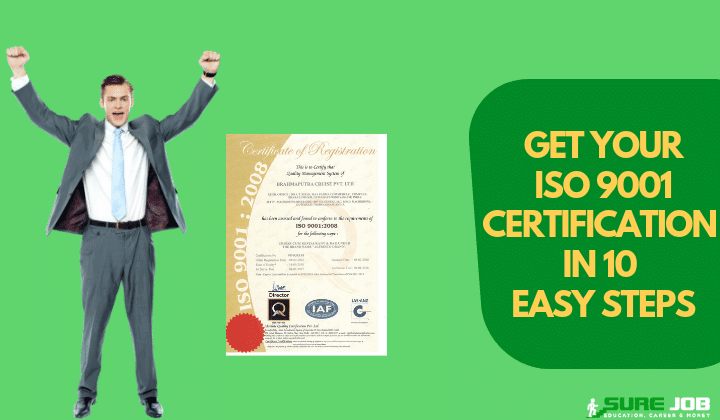Having an ISO (International Organization for Standardization) 9001 certification definitely helps your business to grow. But how to get ISO certification is something very few business owners know.
Here’s your personal step-by-step guide about how to get ISO 9001 certification in 2024. I specifically mention 2022 since standards to get ISO certification often change.

These changes are made to implement newer standards that arise from modern technology, rules and regulations and industry practices.
Let’s start by understanding something about ISO certification, its importance in global industry and trade.
Meaning of ISO 9001 Certification
ISO is an abbreviation for International Standards Organization which operates from Geneva, Switzerland. This organization has a panel of experts that research into best industry practices that are in use worldwide. Based on their findings, they create a set of standards that would be acceptable worldwide.
It’s understandable that different countries in the world are at various levels of development. Hence, ISO also considers these factors while creating standards for companies in such countries to get a certification.
Therefore, don’t believe when anyone says your company has to adopt foreign standards and policies to apply for an ISO 9001 certification.
ISO has different types of standards for various industries. Hence, a company can get one or more ISO certifications, depending upon the nature of business.
ISO 9001 and its variants are all about quality management systems. In simple terms, it deals with implementing the highest Quality Management Systems in every department of a business or organization.
How to Get ISO 9001 Certification
An ISO certification is available to companies of all sizes, regardless whether they are one-man-show operations or a gigantic corporation with branches worldwide.
It involves implementing Quality Management Systems (QMS) within all departments of the organization. And getting the QMS audited and certified by an authorized ISO certifying agency.
You can easily find a list of ISO 9001 certifying agencies in India. Contact these agencies and discuss how to get ISO certification.
Enlisting the help of an ISO 9001 certifying agency proves very helpful and eases various processes. They’ll also provide a roadmap that your organization can follow to get the ISO certification.
1: Define Objectives for ISO 9001 Certification
This is the first and most important step to get ISO certification. You need to define why your organization needs an ISO certification, how it would help the organization and what you plan on achieving with it.
Defining objectives helps you chart a plan of action to implement QMS within various departments of your organization that best serve its aims to increase business and profits.
The ultimate objective of ISO certification is to increase profits by getting business from external parties that will deal only with compliant organizations.
2: Appoint an ISO 9001 Manager
In simple terms, this means appointing a responsible employee to study all features of implementing QMS within the organization. The ISO 9001 Manager’s main task is to identify areas where applying QMS would prove beneficial for the organization.
Usually, an ISO 9001 Manager will study various QMS models and help create one that’s best for the company.
An ISO 9001 Manager will also liaise with an ISO certifying agency to find ways and means to implement QMS, study different QMS models that can best suit the company’s needs while drawing a comprehensive plan for their gradual introduction into regular work.
A gradual approach is better since it doesn’t shell-shock employees due to sudden changes in current work and corporate culture.
3: Prepare QMS Blueprint
A QMS blueprint is essential to test drive your organization for ISO 9001. It will provide a roadmap of practices that have to be implemented across various departments of the organization.
A QMS blueprint is also employee specific. It doesn’t really deal with each individual employee: it considers them as a team that have common goal.
Usually, a QMS blueprint will have the near astute management systems for the organization. However, they are only blueprint and prototype.
There are no guarantees that a QMS model would effectively work in your organization. Hence, you need to take the next step.
4: Put QMS to Test
This is the next step after getting a QMS blueprint ready. This QMS prototype has to undergo testing in real environment that involves humans.
Hence, your employees will have to begin implementing these standards necessary for ISO certification. This can take a couple of weeks or longer, depending on the size of your organization.
When you start testing QMS in a real life work environment, obviously, you’ll witness hurdles of all sorts in the functioning. These hurdles clearly indicate areas where your organization needs improvements if it has to get ISO certification.
5: Do Gap Audit/ Gap Analysis
Hurdles in an organization while implementing QMS usually occur due to two reasons. One is faulty systems while other is the skills gap of employees.
The ISO 9001 Manager here faces an uphill task of evaluating why hurdles occur, finding ways and means to eliminate them and ensure seamless functioning to comply with ISO 9001 certification. Therefore a gap analysis becomes necessary while applying for ISO certification.
Also, a skills gap among employees might indicate some require skills upgrade. In rare instances, the ISO 9001 Manager could also face hostility because some employees would be unwilling to change their existing ways of functioning and adopt new ones that comply with ISO 9001. At this stage, it is important to train all employees.
6: Employee Training
Now comes the crucial part of actually training employees to implement QMS in all areas of operation within the organization.
Training should also focus on the reduction and elimination of the skills gap. Employees have to be aware of their organization seeking ISO certification and hence, their cooperation is vital.
Employee training to comply with ISO 9001 standards is not a one-off exercise: Instead, it’s an ongoing process that continues in the form of day to day functioning.
The overall objective of such training is to ensure seamless working, create excellent teamwork within teams and between different departments as well as adhering to QMS standards of ISO 9001.
7: Prepare Documents
Now comes the next step of preparing documents that an external ISO 9001 certifying agency will require for auditing your organization. A variety of documents will be necessary for this process.
These include documents such as company registration, charter of association- in case of partnerships, HR rules and regulations, company policies towards external stakeholders, customer care framework and other guidelines.
Here, it’s vital to remember that only documents won’t suffice. Your organization has to actually prove that it functions on their basis that are QMS compliant.
You can get an external auditor to audit functioning of your organization at all levels before filing for the final ISO 9001 certification.
8: Apply for ISO Certification
All the above processes usually should be complete in around 90 days to 120 days- or about three months. Once the ISO 9001 Manager from your organization is satisfied, the next obvious step is to apply with one of the many external agencies authorized to audit and certify your organization as ISO 9001 compliant.
The certifying agency will provide a checklist of QMS. The ISO 9001 Manager has to satisfy the certifying agency about the organization meeting these standards.
This is essential because no certifying agency will waste time, resources and efforts in auditing an organization that doesn’t remotely meet ISO 9001 standards.
9: ISO 9001 Audit
The certifying agency will commence auditing your QMS on your premises. Their findings will decide whether or not your organization is ISO 9001 compliant.
Failing in the first audit doesn’t necessarily disqualify your organization from getting an ISO certification. The external agency will provide a checklist of areas where your organization might require some improvements.
The certifying agency will also study various documents that concern QMS and ISO 9001 certification of your organization. This overall audit aims to find that your organization merits the ISO 9001 certification.
And if you’ve followed the procedure correctly, there’s every chance your organization will be successful and be certified as ISO 9001 compliant.
10: Monitoring & Improving
Remember, the initial ISO certification is valid for a period of three years only. It’s not a one-off certification. Your organization needs to qualify for renewal.
Hence, it’s extremely essential to monitor and improve your QMS in every area of operations. This can involve continuing training for employees, improving customer service and lots of other functions.
Apply for renewal of your ISO 9001 certification once you are confident that your organization now meets and exceeds all standards.
This is possible only through continual improvements and monitoring QMS practices while implementing newer ones that would find ISO 9001 approval.
It’s worth remembering that QMS standards can undergo a drastic change over a period of three years and your organization has to keep pace if it hopes to renew the ISO 9001 certification.
Finding ISO 9001 Resources
Thanks to the Internet, there’s lots of free resources and reference material available for newcomers to ISO 9001. Some resources and assistance will be available from the ISO certifying agency you approach.
Also, a lot of resources can also be bought online to assist your ISO 9001 manager and other employees.
This helps prepare well for an ISO certification and ensures you get it on the first go. You can also appoint external agencies to train staff in the implementation of QMS within your organization.
Wrap Up
An ISO certification is excellent for any organization that wants to flourish. Nowadays, most companies prefer dealing with suppliers, contractors and other providers that are ISO 9001 compliant: it’s an assurance of getting the best service.
An ISO 9001 certification helps you bid for major contracts in India and abroad. This is very useful at a time when the country is forging ahead with the Make in India initiative.
Therefore, approach an ISO audit company and try to get the process rolling at the earliest.
Lagging in getting an ISO 9001 compliance certificate can cost dearly: you could lose on some very lucrative and major contracts that are emerging nowadays.
In the retail business too, customers are more inclined to shop from ISO 9001 compliant organizations since they look for quality. An ISO 9001 compliance can help your organization immensely.








